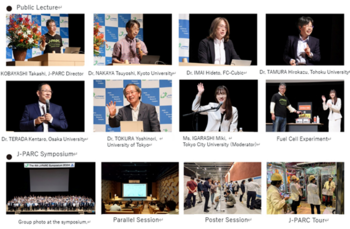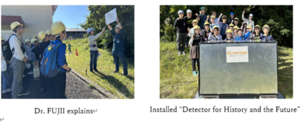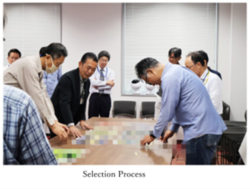J-PARC News October 2024 (Issue #234)
■Thank you for coming to the J-PARC Open House ( September 28th )
This year's Open House was held on a cloudy, pleasant day after the long, sizzling summer had finally come to an end.
Visitors toured the extensive site, looking closely at the experimental facilities and exhibits and asking lots of questions. There were about 1,000 visitors, 40% of whom came from outside Ibaraki Prefecture, and a lot of them looked around with great interest until the very end of the tour. During the Open House, there was also a ceremony to mark the signing of a cooperative agreement with Tokai Village, and five presentations were given as part of the Hello Science program. We look forward to seeing you all again next year.
■The 4th J-PARC Symposium was held (October 14th-18th, Mito City Civic Center)
This year marks 15 years since the start of the operation of all J-PARC facilities, and the 4th J-PARC Symposium 2024 (J-PARC2024) was held under the theme of ‘Futures of J-PARC, Futures by J-PARC’.
On the first day, a public lecture was held on ‘The future created by J-PARC, the mysteries explored by J-PARC - from Next-Generation Energy to Space’. Five researchers involved in cutting-edge research using J-PARC facilities gave an accessible account of their work, from particle and nuclear physics and neutron-based fundamental research to industrial applications. While it was a perfect day for an outing, with fine weather on the last day of the three-day weekend, many people came to listen to the talks, and after each talk there were so many questions that we didn't have enough time to answer them all.
From the 15th to the 17th, plenary sessions, parallel sessions and poster sessions were held, focusing on the achievements in various fields at J-PARC over the past 15 years, the future development of J-PARC, and the impact of the technologies and experience generated at J-PARC on accelerators and experimental facilities around the world. There were 93 oral presentations and 290 poster presentations covering all areas of research conducted at J-PARC, from particle and nuclear physics to safety, and more than 400 researchers from Japan and overseas engaged in lively discussions. On the 18th, participants enjoyed tours of the Linear Accelerator, the Materials and Life Science Experimental Facility, the Hadron Experimental Facility, and the Neutrino Experimental Facility.
■Peculiar propagation of lattice wave in the third solid state ‘Quasicrystals’.
- Lattice waves proceeding with scattered everywhere and propagating differently forward and backward (September 27th)
Solids can be classified into three categories: crystalline, amorphous and quasicrystals based on the ordering of their atomic arrangement. In this study, we performed inelastic neutron scattering experiment on lattice dynamics of quasicrystal AlPdMn with various energy resolutions by using the cold-neutron disc-chopper spectrometer ‘AMATERAS’ and the biomolecular dynamics spectrometer ‘DNA’ at the Materials and Life Science Experimental Facility (MLF). The hierarchical fine gap structure was found in the lattice waves (phonons), indicating that phonons are scattered everywhere due to the quasiperiodic structure. Furthermore, a detailed investigation of the phonon intensity revealed that the phonons in quasicrystals are asymmetric in energy and wave vectors.
The elucidation of lattice dynamics also provides valuable insights for understanding the dynamics of other degrees of freedom, such as charge and spin in quasicrystals. Additionally, nonreciprocal nature of phonons in quasicrystals can be used for thermal management applications to control phonon flow.
■Experimental verification of a new concept of magnetic materials.
- Neutron scattering experiments on altermagnetic materials - ( October 9th )
Altermagnetic materials are attracting attention as a new concept of magnetic materials in addition to ferromagnetic and antiferromagnetic materials. In this study, high quality large single crystals of MnTe were synthesized and inelastic neutron scattering experiments were performed using the High Resolution Chopper Spectrometer ‘HRC’ at the J-PARC MLF. As a result, the theoretically predicted spectral splitting of magnons in altermagnets was successfully observed for the first time in the world. Further detailed analysis revealed that the observed magnons are chiral magnons carrying spin currents.
This discovery will contribute to a better understanding of altermagnetism, provide new guidelines in the search for superconducting materials and advance spintronic devices. In the future, faster and more efficient electronic devices will become a reality and could revolutionize our daily lives.
■Scientific Activities for Kids at the Ozora Marche (October 5th, Tokai Village)
As in previous years, J-PARC took part in the Ozora Marche, one of the four major festivals in the Tokai Village.
There were various workshops, food courts, and live stages set up in the precincts and along the approaches to the Grand Shrine and Muramatsu Kokuzoudo.
At the very back of the precincts, J-PARC gave demonstrations of a superconductive coaster and held a craft workshop for making kaleidoscopes. Although the weather was unfavorable, with rain on and off, many people, including families, stopped by.
■“Detector for History and the Future” started muon measurements at Funatsuka No.2 Burial Mound ( October 13th)
Under a crisp autumn sky on the middle day of a three-day weekend, a muon detector named “Detector for history and the future” that was built with children last year, was finally installed in the Arayadai residential water distribution station adjacent to Funatsuka No. 2 Burial Mound.
The work of lifting the detector on a truck with crane and installing it at the designated site was very delicate and the 17 children watched with bated breath as Dr. Fujii of the J-PARC Center explained the situation. At the end of the installation, the children helped covering the detector with a waterproof sheet. When the detector was switched on after installation, muon signals appeared on the computer screen and the children cheered.
Over the next few months, the members will be measuring cosmic ray muons and analyzing the data. At the same time, they will start building the second detector next month. We are very excited to see what kind of results they’ll get and what kind of detector they’ll complete.
■J-PARC Sanpo-michi 51 - J-PARC Photo Contest -
The main actors of J-PARC are protons in enormous numbers, accelerated to near the speed of light, as well as the secondary particles such as neutrons, muons, neutrinos, and hadrons that are produced when these protons hit their targets. Unfortunately, none of these particles can be seen with the naked eye, but J-PARC hopes to use the medium of photography to help people understand the research activities taking place here. The huge facilities and the equipment ( the most advanced of their kind in the world ) may seem boring, but enlarging parts of the particles, making effective use of light, and adding people and natural landscapes, we can both excite viewers and make them feel serene.
A photo contest is held every year at around this time, and this year’s is the 11th one. The winning photos will be used in various kinds of publicity, including next year’s calendar.






